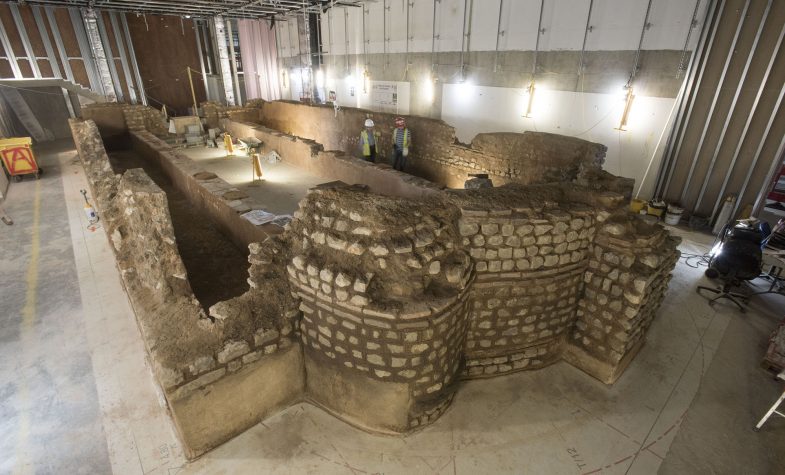Below Bloomberg’s monumental new European headquarters in the City of London lies an ancient Roman temple dating back to circa AD240. Dedicated to the Roman God Mithras, the London Mithraeum is one of most significant archaeological sites in Britain. Over 14,000 individual artefacts have been discovered there, including a sculpted head of Mithras, an amber Gladiator amulet and 406 wooden writing tablets including Britain’s earliest known handwritten document.
When it was discovered in 1954, the Temple of Mithras was (controversially) relocated to Queen Victoria Street, to allow for the construction of an office block on its site. But the new Bloomberg architecture sees the relics returned to their rightful home, and reunited with parts of the remains, which had not been previously excavated, to co-exist in harmony with the contemporary buildings above.
As part of Bloomberg’s pledge to create a new public realm in the City, the temple, now called the London Mithraeum Bloomberg Space, is open to visitors six days per week (Tuesday – Sunday), and offers a fascinating glimpse into Roman Londinium and what life was like 2,000 years ago.
The three-storey museum leads visitors through an exhibition space for original artworks inspired by the history of the site, currently occupied by Dublin-based artist Isabel Nolan; a display of the fascinating array of artefacts, which have been recovered and an introduction to religion in Roman times and the cult of Mithras. They will then descend into the original ancient temple, which now sits seven metres below modern street level and is brought to life by an immersive light and sound show.

Back above ground, additional elements of the Bloomberg architecture offer further reminders of the site’s Roman origins. The Bloomberg arcade, a public walkway between the headquarters’ two buildings, recovers a lost portion of Watling Street – an important ancient road that ran from Dover to London, and on to St Albans, another Roman settlement. The covered arcade aims to revitalise the passage to its former glory as a bustling thoroughfare – ten independent restaurants, offering cuisine from around the world, have taken up residence and now provide a new recreational space for workers, residents and visitors.
Finally, a specially commissioned water sculpture by Spanish artist Cristina Iglesias has been installed in two of the three public plazas that mark each corner of the development. Forgotten Streams is inspired by the ancient Walbrook River that used to run through the site. Water flows over layers of cast bronze branches and leaves, its force fluctuating throughout the course of each day – a reminder of the ebb and flow of life, and the historic significance of this area, which has been at the heart of the city for millennia.

‘The arts help cities thrive – that’s why our company has been a strong supporter of the arts in cities around the world,’ said Michael Bloomberg, founder of Bloomberg LP and Bloomberg Philanthropies. ‘The art at our new European headquarters makes our workplace more exciting and inspiring, and it helps to connect us to the surrounding community.’
Further original artworks by leading contemporary artists occupy prime positions within the Bloomberg buildings and, although inaccessible to the public, some can be glimpsed from the outside thanks to the transparency of the architecture. A good view of David Tremlett’s City Drawing #1 in the south building reception hall can be seen from the street, particularly at nighttime. And a wall painting by Arturo Herrera that covers the curved wall of the sixth floor dining room is visible from some neighbouring buildings, including the adjacent rooftops. Other specially commissioned works have been deliberately positioned so they are encountered by visitors to the building, including a sculpture by Olafur Eliasson in the central Vortex of the entrance lobby and a three-piece tapestry work by Pae White that hangs in the pre-event space for the auditorium.

London Mithraeum Bloomberg Space is free to visit, and advance bookings are recommended; londonmithraeum.com











